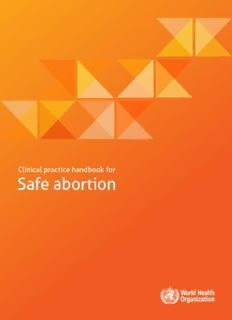
Safe abortion PDF
Preview Safe abortion
Clinical practice handbook for Safe abortion Clinical practice handbook for Safe abortion Acknowledgements: WHO is very grateful for the technical contributions of both external experts and past and present WHO staff who informed the development of this document. WHO Library Cataloguing-in-Publication Data Clinical practice handbook for safe abortion. 1.Abortion, Induced – methods. 2.Abortion, Induced – standards. 3.Practice guideline. I.World Health Organization. ISBN 978 92 4 154871 7 (NLM classification: WQ 440) © World Health Organization 2014 All rights reserved. Publications of the World Health Organization are available on the WHO website (www.who.int) or can be purchased from WHO Press, World Health Organization, 20 Avenue Appia, 1211 Geneva 27, Switzerland (tel.: +41 22 791 3264; fax: +41 22 791 4857; e-mail: [email protected]). Requests for permission to reproduce or translate WHO publications – whether for sale or for non-commercial distribution – should be addressed to WHO Press through the WHO website (www.who.int/about/licensing/copyright_form/en/index.html). The designations employed and the presentation of the material in this publication do not imply the expression of any opinion whatsoever on the part of the World Health Organization concerning the legal status of any country, territory, city or area or of its authorities, or concerning the delimitation of its frontiers or boundaries. Dotted lines on maps represent approximate border lines for which there may not yet be full agreement. The mention of specific companies or of certain manufacturers’ products does not imply that they are endorsed or recommended by the World Health Organization in preference to others of a similar nature that are not mentioned. Errors and omissions excepted, the names of proprietary products are distinguished by initial capital letters. All reasonable precautions have been taken by the World Health Organization to verify the information contained in this publication. However, the published material is being distributed without warranty of any kind, either expressed or implied. The responsibility for the interpretation and use of the material lies with the reader. In no event shall the World Health Organization be liable for damages arising from its use. Printed in (country name) Design and layout by ACW, London Abbreviations AIDS a cquired immunodeficiency syndrome D&E dilatation and evacuation EVA electric vacuum aspiration Hb haemoglobin hCG human chorionic gonadotrophin HIV human immunodeficiency virus ICD International statistical classification of diseases IM intramuscular IUD intrauterine device IV intravenous LMP last menstrual period MVA manual vacuum aspiration NSAID n on-steroidal anti-inflammatory drug POC products of conception Rh Rhesus (blood group) STI sexually transmitted infection VA vacuum aspiration WHO World Health Organization 2 Abbreviations Definitions Duration or gestational age of pregnancy The number of days or weeks since the first day of the woman’s last normal menstrual period (LMP) in women with regular cycles (for women with irregular cycles, the gestational age may need to be determined by physical or ultrasound examination). The first trimester is generally considered to consist of the first 12 or, by some experts, as the first 14 weeks of pregnancy. Throughout this document, gestational age is defined in both weeks and days, reflecting its definition in the International statistical classification of diseases (ICD)*. Medical methods of abortion (medical abortion) Use of pharmacological drugs to terminate pregnancy. Sometimes the terms “non-surgical abortion” or “medication abortion” are also used. Osmotic dilators Short, thin rods made of seaweed (laminaria) or synthetic material. After placement in the cervical os, the dilators absorb moisture and expand, gradually dilating the cervix. Surgical methods of abortion (surgical abortion) Use of transcervical procedures for terminating pregnancy, including vacuum aspiration, and dilatation and evacuation (D&E). * I nternational statistical classification of diseases and health related problems, 10th revision – ICD-10, Vol. 2, 2008 edition. Geneva: World Health Organization; 2009. Definitions 3 Purpose of the handbook The Clinical practice handbook for safe abortion care is intended to facilitate the practical application of the clinical recommendations from the second edition of Safe abortion: technical and policy guidance for health systems (World Health Organization [WHO] 2012). While legal, regulatory, policy and service-delivery contexts may vary from country to country, the recommendations and best practices described in both of these documents aim to enable evidence-based decision-making with respect to safe abortion care. This handbook is oriented to providers who already have the requisite skills and training necessary to provide safe abortion and/or treat complications of unsafe abortion. It is neither a substitute for formal training, nor a training manual. We hope this handbook will be useful to a range of providers in different settings and in varying legal and health service contexts. 4 Purpose of the handbook Guiding principles Providers should be aware of local laws and reporting requirements. Within the framework of national laws, all norms, standards, and clinical practice related to abortion should promote and protect: w omen’s and adolescents’ health and their human rights; i nformed and voluntary decision-making; a utonomy in decision-making; n on-discrimination; c onfidentiality and privacy. Some practical examples of how providers can apply these principles include: t reating all women equally regardless of age, ethnicity, socioeconomic or marital status, etc., in a prompt and timely fashion; e nsuring that abortion care is delivered in a manner that respects all women as decision-makers; p roviding complete, accurate and easy to understand information; respecting the dignity of the woman, guaranteeing her privacy and confidentiality; b eing sensitive to the needs and perspectives of the woman; p rotecting medical information against unauthorized disclosures; b eing aware of situations in which a woman may be coerced into having an abortion against her will (e.g. based on her health status, such as living with HIV); w hen dealing with adolescents, encouraging parents’ engagement through support, information and education. Do not insist on parents’ authorization, unless it is a legal requirement. Guiding principles 5
Description: